
Old State House ‘means everything’ to city
BOSTON — The Old State House sitting in the center of this old New England city represents the foundation of American history and the events that led up to its freedom from Britain.
“The house means many things to the city of Boston,” according to Tiffany, the office manager at the Bostonian Society. “It represents our colonial past and heritage.”
The Old State House was first built in 1657.
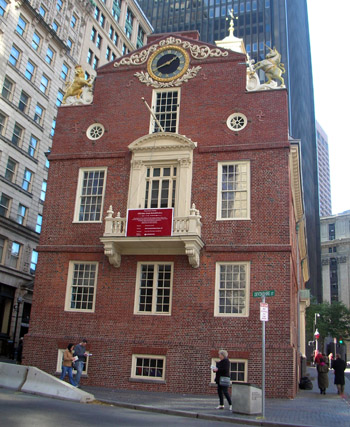 |
The site where the Boston Massacre took place directly below the balcony of the Old State House (Photo by Tiffany Barranco). |
Back then it was called the Townhouse. In 1711, a fire destroyed the Townhouse, which was a symbol of stability and stood for “Mother England,” but it was immediately rebuilt.
The Townhouse, as it was called then, was a place where people applied for marriage licenses, land transactions, and business and trade took place there. The Superior Court also held station there, along with the Superior Court; the colonial government was seated there.
The Townhouse acted as middle ground that connected colonists in Massachusetts to the mother country.
As relationships with the mother country became frayed, the Townhouse became a great public political stage where the voices of the colonists could be heard. There the colonists spoke out against the “writs of assistance” and against other unfair laws that had come into place.
On March 5, 1770, an event that became the turning point in American history took place on the steps right outside the “Townhouse.”
On that night, colonists had become angry at the tariffs that were placed on different goods such as tea. The colonists had had enough. A mob of them stood outside chanting and their anger grew. The guards outside the Townhouse grew restless and some fearful. Shots were fired and five colonists were shot and killed.
The Boston Massacre had taken place, forever changing the colonists’ relationship with the mother country and there began a movement toward revolution.
| Clothing once worn by Revolutionary leader John Hancock as well as some of his journals and letters are on display in the Old State House exhibits area (Photo by Tiffany Barranco). | 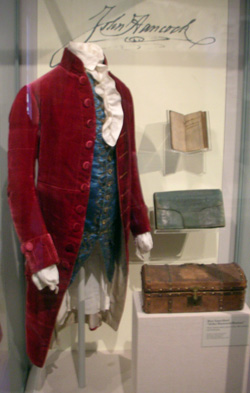 |
In 1776, the Declaration of Independence was read from the balcony of what now was known as the State House. And later John Hancock made the State House his home as the first governor of Massachusetts.
Although it is seen today as a treasure that has been saved and preserved, it was not always such a valued place.
In 1780, Boston’s government had become so large that it moved out of what is known today as the Old State House. The Old State House then became a commercial place where goods were bought and sold. It was market to the people of Boston and was becoming run down.
In 1881, the City of Chicago saved the Old State House from demolition. Chicago had realized the important role it played in the history of our country and wanted to buy it and move it to Chicago to make it a museum.
Boston realized just how important the preservation of the Old State House was and began measures to see it preserved after the construction of subway tunnels directly underneath the Old State House altered the eastern portion of the building.
In 1908, the city hired Joseph Everett Chandler, Boston’s foremost restoration architect, to restore it to “as nearly as possible to its provincial condition.”
Since that restoration several others have taken place.
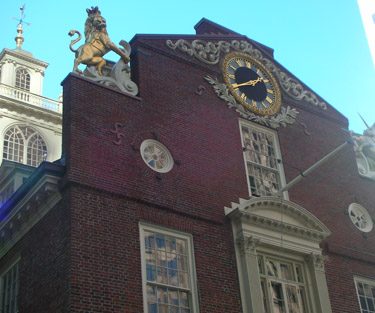 |
The original clock on the Old State House still sits above the balcony (Photo by Tiffany Barranco). |
The Council Chamber part of the Old State house, which is in the northeast corner, was restored to a more colonial appearance in 1943.
The most recent and largest preservation project took place in 1991. The city conserved and repaired the structure maintaining as much of the existing building as possible.
Today, the Old State House is protected as part of Boston’s Freedom Trail. Privately administered, its meaning and role that it played in our country’s foundation does not go unnoticed.
Today, the Old State House serves as a museum and library displaying the not only the history of Boston, but of the nation.
On the first floor is where admission is paid to enter the Old State House. On that same floor there is a gift shop filled with different American Revolution souvenirs such as ties, books, mugs, and posters. Past the store, is a room that plays a video detailing the history of the Old State House, along with a timeline on the walls.
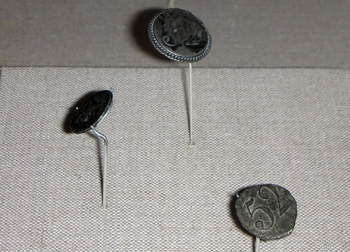 |
Revolutionary War era uniform buttons on display (Photo by Tiffany Barranco). |
The second floor is full of artifacts found from the Revolutionary War. Among them are muskets, Paul Revere’s spoon, Revolutionary War coat buttons, John Hancock’s clothing along with letters and journals he kept.
“It is amazing all the things you find in here that you once read about in your history books,” said Lorie Jarsen, a freshman at Boston University.
The basement floor of the Old State House contains photographs on the wall depicting different times in Boston’s history.
Each time a person walks through the doors of the Old State House, he or she discovers the treasure that has been preserved.
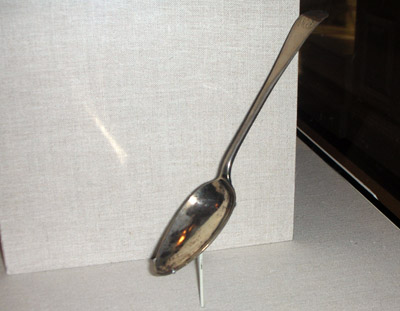 |
An original spoon that belonged to Paul Revere around the time that he warned the colonists that the British were coming (Photo by Tiffany Barranco). |
If You Go
Address:
206 Washington St., Boston, Mass. 02109
Directions:
- By MBTA (recommended)
Take the Orange or Blue Lines to State Street. Follow signs for “Old State House” to street level. The station is directly beneath the Old State House; the Library is across the pedestrian mall at 15 State St. (under the National Park Service Visitor Center sign).
OR take the Green Line of the MBTA to Government Center and walk down Court Street one block to State Street.
OR take the Red Line to Downtown Crossing and walk down Washington Street toward City Hall to State Street (several blocks). - Driving from the North: Take I-93 South to the Haymarket exit. Turn right on New Chardon Street and take your first left onto Congress Street at the traffic lights. Continue on Congress past Faneuil Hall on your left and Boston City Hall on your right. At the next intersection (Congress and State Streets), you will see the Old State House on your right. The Library is across the pedestrian mall at 15 State St., (under the National Park Service Visitor Center sign
- Driving from the South: Take I-93 North and keep right in the South Station tunnel. Exit at the sign for Atlantic Avenue. Stay to the left on Atlantic and make a left turn at the State Street traffic light (New England Aquarium is on the right). The Old State House is directly ahead. The Library is across the pedestrian mall at 15 State St. (under the National Park Service Visitor Center sign).
- Driving from the West: Take the Mass Pike (I-90) to I-93 North. Continue with “Driving from the South” directions.
- Driving from Cambridge: Take the Longfellow Bridge to Cambridge Street. Follow Cambridge Street to the New Sudbury Street traffic light. Make a left turn onto New Sudbury and then a right onto Congress Street. Continue on Congress past Faneuil Hall on your left and Boston City Hall on your right. At the next intersection (Congress and State) you will see the Old State House on your right.
Parking: There are several parking garages in the vicinity of the Old State House. Suggestions: 75 State Street Garage, 75 State St., 617-742-7275 and the Pike Alley Parking Garage, 275 Washington St., 617-720-2006.
Contact: Telephone: 617-720-1713, Web site: http://www.bostonhistory.org.
Hours: Open daily from 9 a.m. to 5 p.m., with extended hours in the summer. Closed New Year’s Day, Thanksgiving Day and Christmas Day.
Admission: Adults $5, older adults (62+) $4,students (over 18) $4, children (6-18) $1. Group rates available with a reservation. Members, children under six, visitors with disabilities, Boston older adults and Boston schoolchildren are admitted free at all times. No admission is charged for visitors to the Old State House museum shop.

Comments are Closed